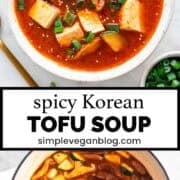This spicy Korean tofu soup is everything you need for a comforting meal: tofu, veggies, and a rich, flavorful broth, all coming together in just 30 minutes for a quick and easy dish.
Looking for more tofu recipes? Be sure to check out my Spicy Korean Tofu, Kung Pao Tofu, and Tofu Stir Fry. Each recipe gives tofu a fun twist, perfect for anyone craving a tasty meal that’s both satisfying and simple to make.
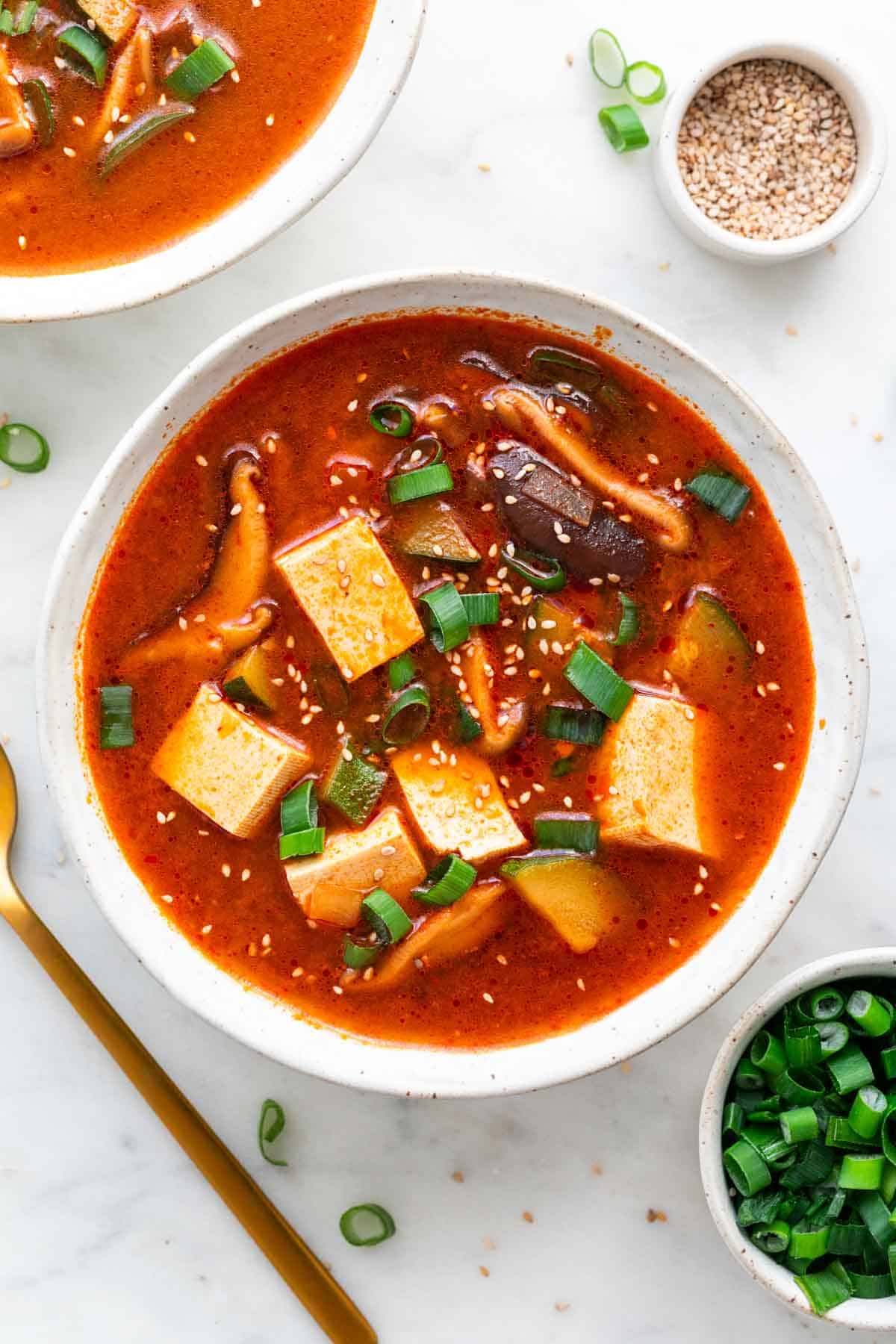
This tofu soup is a comforting, flavorful dish that brings the perfect balance of heat and umami. The tofu soaks up the rich, spicy broth, while the veggies add a fresh crunch that complements the smooth texture of the tofu.
With bold flavors and a comforting warmth, it’s perfect for chilly nights or whenever you want a quick, filling meal. You can easily swap in your favorite veggies or adjust the spice level to match your taste.
Ingredients for spicy Korean tofu soup
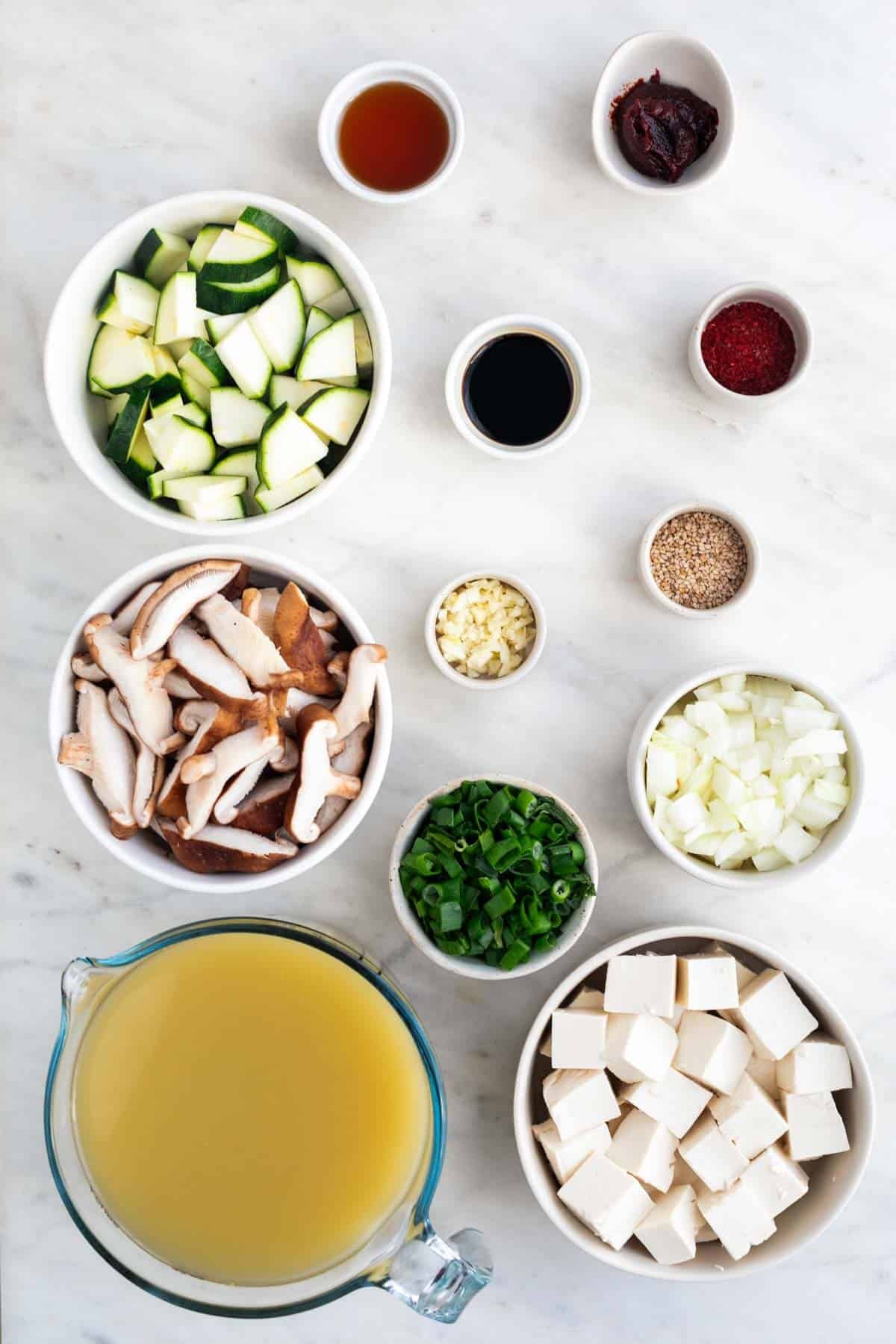
- Oil: I used sesame oil for its toasted flavor that gives an extra touch to Asian-inspired dishes, but you can use any oil, like olive or vegetable, if you don’t have it.
- Onion: You can use yellow or white onion, though yellow onions caramelize better. Red onion or shallots work too for a different taste.
- Garlic.
- Gochugaru: This Korean chili flake has a mild, slightly smoky flavor, adding just the right amount of heat without being overpowering. You can find gochugaru at Asian markets, online, or even in larger grocery stores with an international aisle. If you can’t find it, crushed red pepper flakes or paprika can be used as substitutes for a similar mild heat.
- Vegetable broth: If you don’t have vegetable broth, you can use water, though the flavor will be milder. Adding a pinch of salt or spices like garlic powder can help boost the taste.
- Gochujang: This Korean fermented chili paste is spicy, salty, and a little sweet, adding a unique flavor to the soup. You can find it at Asian markets, online, or in grocery stores with international sections. If you can’t find it, substitute with 1 teaspoon of gochugaru, a pinch of sugar, and a splash of soy sauce, or use sriracha or chili paste with sugar.
- Soy sauce: Soy sauce adds saltiness and umami to the dish. You can use low-sodium soy sauce for a milder flavor, or substitute with tamari for a gluten-free option, or coconut aminos for a soy-free alternative.
- Zucchini.
- Shiitake mushrooms: If you can’t find them, you can substitute with other mushrooms like cremini, button, or portobello.
- Silken tofu: It is the best option for this soup due to its smooth, creamy texture that easily breaks down, soaking up the flavors of the broth. If you prefer, you can substitute it with soft or medium tofu for a similar texture, or use firm, extra-firm, or even fried tofu for a firmer texture.
- Sesame seeds: Optional.
- Scallions or green onions: Optional.
Find the full recipe with exact measurements in the recipe card below.
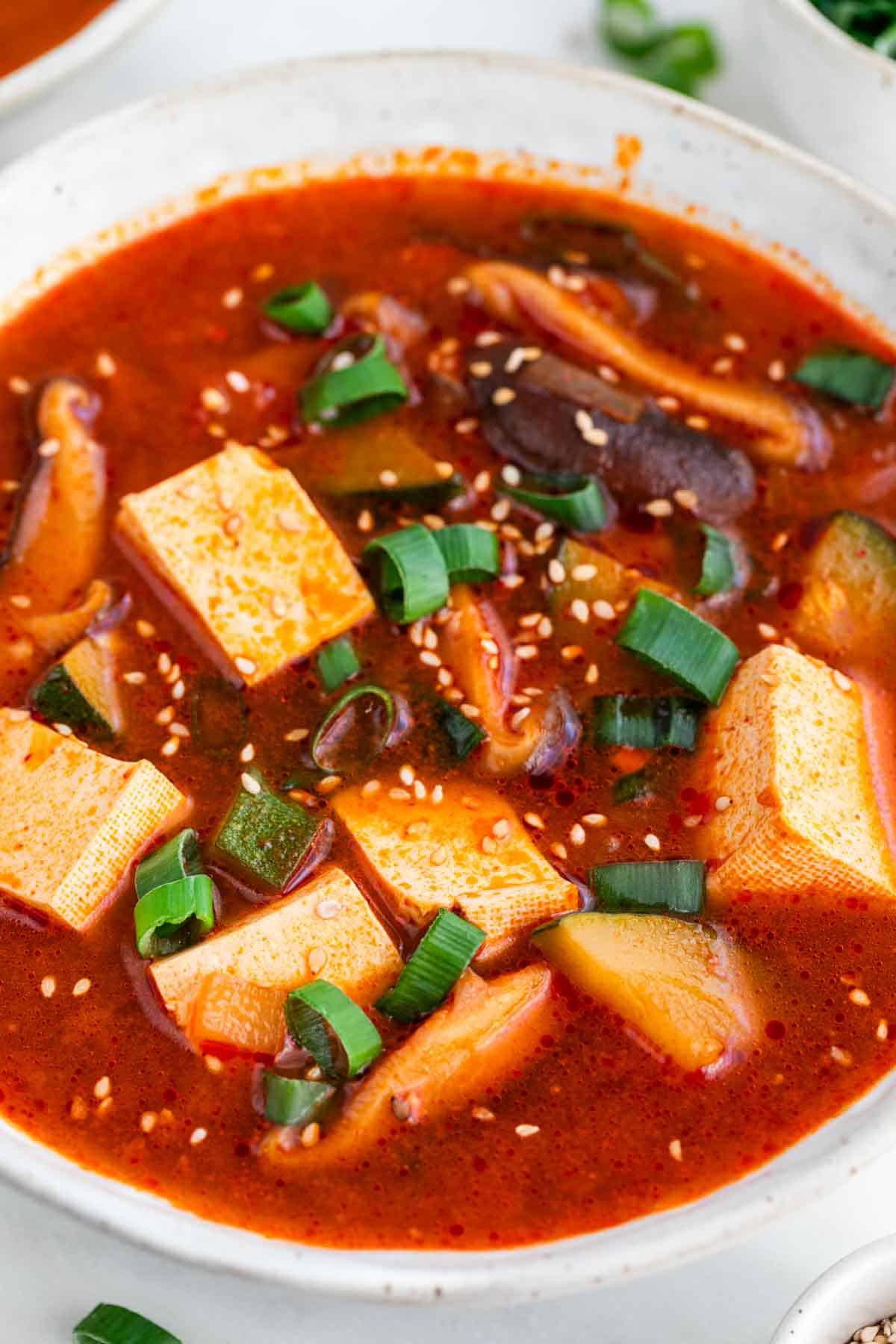
Storage instructions
Fridge: Store the soup in an airtight container in the fridge for up to 3-4 days.
Freezer: You can freeze the soup in an airtight container or freezer bag for up to 2-3 months.
Reheat: To reheat, if the soup is stored in the fridge, simply heat it in a pot over medium heat, stirring occasionally, until it’s warmed through. If the soup is frozen, it’s best to thaw it overnight in the fridge first. Once thawed, heat it in a pot over medium heat until hot. If reheating directly from frozen, simmer it gently in a pot, adding a little water or broth to reach your desired consistency.
Frequently asked questions
Silken tofu is a type of tofu that has a smooth, creamy texture, making it perfect for soups, smoothies, and creamy dishes. Unlike regular firm tofu, silken tofu is soft and delicate, and it easily breaks down into the broth, absorbing all the flavors.
Yes, you can use other types of tofu, but keep in mind that the texture will change. Soft or medium tofu can be used for a similar creamy texture, but if you prefer a firmer tofu, you can substitute with firm or extra-firm tofu. These will hold their shape better but won’t create the same smooth texture as silken tofu.
No, tofu does not need to be cooked before adding it to the soup. Since it’s already pre-cooked, you can simply add it directly to the soup and heat it through.
You can add any veggies you like! Some great options are spinach, carrots, bell peppers, baby corn, or whatever veggies you have at home. Just adjust the cooking time based on how long they take to soften!
This Korean tofu soup pairs perfectly with a bowl of steamed rice to soak up the flavorful broth. You can also serve it with some crusty vegan bread or even a simple side salad for a well-rounded meal. If you want to keep it traditional, try it with vegan kimchi on the side for an extra burst of flavor.
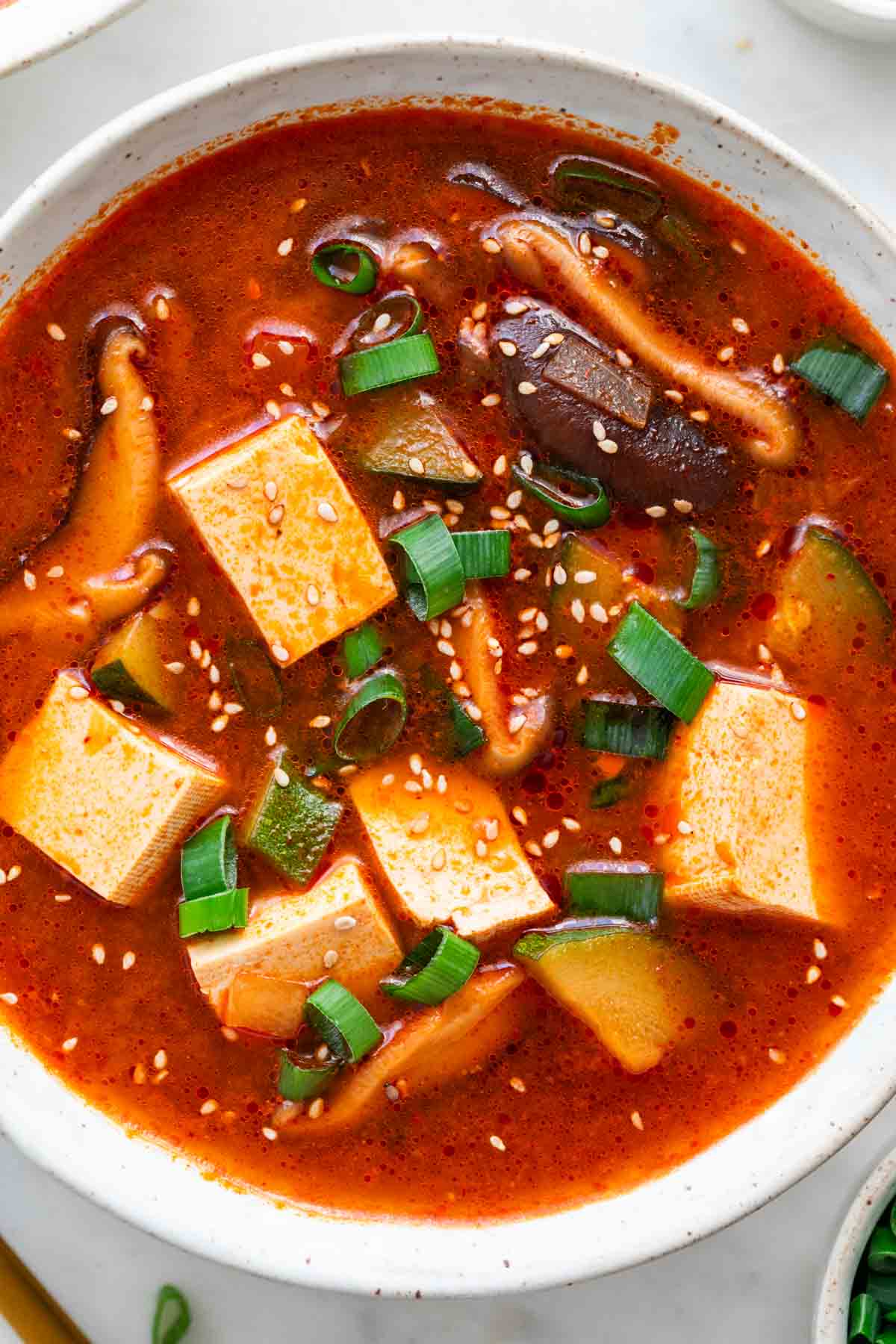

Spicy Korean Tofu Soup
This spicy Korean tofu soup is everything you need for a comforting meal: tofu, veggies, and a rich, flavorful broth, all coming together in just 30 minutes for a quick and easy dish.
Servings:
PRINT PIN COMMENT
Ingredients
Prevent your screen from going dark
Instructions
-
Sauté the onion: Heat the oil in a large pot over medium heat. Once hot, add the onion and sauté for about 5 minutes, or until it becomes soft and translucent.
-
Cook garlic and gochugaru: Add the garlic and gochugaru, stir, and cook for 1-2 minutes, or until fragrant.
-
Add broth ingredients and vegetables: Add the vegetable broth, gochujang, soy sauce, zucchini, and shiitake mushrooms, then stir.
-
Bring to a boil: Bring the soup to a boil, then reduce the heat and simmer for about 10 minutes, or until the zucchini and mushrooms are tender.
-
Stir in the tofu: Gently fold in the silken tofu and cook for 1-2 minutes, until heated through.
-
Garnish: Serve the soup in bowls and add chopped scallions and sesame seeds on top (optional).
Notes
- If you’re unsure about the spice level, begin with a smaller amount of gochujang and adjust as the soup cooks to find the perfect heat for you.
- Store in the fridge for up to 3-4 days in an airtight container.
- Freeze for up to 2-3 months in an airtight container or freezer bag.
- To reheat, warm in a pot over medium heat. For frozen soup, thaw overnight and reheat, or simmer from frozen, adding a little liquid if needed.
Nutrition
Serving: 1serving | Calories: 145kcal | Carbohydrates: 16g | Protein: 7g | Fat: 7g | Saturated Fat: 1g | Polyunsaturated Fat: 3g | Monounsaturated Fat: 2g | Sodium: 1216mg | Potassium: 550mg | Fiber: 3g | Sugar: 7g | Vitamin A: 823IU | Vitamin C: 13mg | Calcium: 59mg | Iron: 2mg


